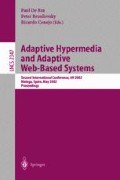Abstract
This paper analyses one of the most well-known general purpose adaptive hypermedia systems, AHA!, and, based on this analysis, make some general observations about adaptive hypermedia systems and some improvement suggestions for the AHA! system. We suggest here a concept-based approach to the structuring of adaptive hypermedia systems, as well as an extension of the well-known rule-based overlay method for user-adaptation. This approach is another step towards flexible generic-purpose adaptive hypermedia.
Access this chapter
Tax calculation will be finalised at checkout
Purchases are for personal use only
Preview
Unable to display preview. Download preview PDF.
References
AHA, Adaptive Hypermedia for All; http://aha.win.tue.nl/
Bernstein, M.: Patterns of Hypertext. Ninth ACM Conference on Hypertext (1998) 21–29
Brusilovsky, P.: Methods and Techniques of Adaptive Hypermedia. User Modeling and User-Adapted Interaction 6 (1996) 87–129
Calvi, L.: ‘Lector in rebus’: the Role of the Reader and the Characteristics of Hyperreading. Tenth ACM Conference on Hypertext’ 99. ACM Press (1999) 101–109
Calvi, L., De Bra, P.: Using Dynamic Hypertext to Create Multi-Purpose Textbooks. In T. Müldner and T.C. Reeves (eds.), ED-MEDIA’97, AACE Press (1997), 130–135
Cristea, A., Okamoto, T.: MyEnglishTeacher — A WWW System for Academic English Teaching ICCE 2000, Taipei, Taiwan (2000)
De Bra, P., Calvi, L.: AHA! An open Adaptive Hypermedia Architecture. The New Review of Hypermedia and Multimedia (1998) 115–139
De Bra, P., Ruiter, J.P.: AHA! Adaptive Hypermedia for All. WebNet (2001) 262–268
Eco, U.: Six Walks in the Fictional Woods. Harvard University Press (1994)
Goldman, A.: Telerobotic Knowledge: A Reliabilist Approach. In K. Goldberg (ed.). The Robot in the Garden. Telerobotics and Telepistemology in the Age of the Internet. MIT Press (2000) 126–142
Kendall, R.: A Life Set For Two. Eastgate Systems, Watertown, MA (1996)
Kendall, R., Réty, JH.: Toward an Organic Hypertext. Hypertext’ 00. (2000) 161–170
Idinopulos, M.: Telepistemology, Mediation, and the Design of Transparent Interfaces. In K. Goldberg (ed.). The Robot in the Garden. Telerobotics and Telepistemology in the Age of the Internet. MIT Press (2000) 312–329
Goldstein, I.: The genetic graph: a representation for the evolution of procedural knowledge. In D. Sleeman and J.S. Brown (eds, Intelligent Tutoring Systems. Academic Press, 1982.
Joyce, M.: Nonce Upon Some Times: Rereading Hypertext Fictions. Modern Fiction Studies 43(3) (1997) 579–597
Learner Model. IEEE Learning Technology Standards Committee (LTSC); http://ltsc.ieee.org/wg2/index.html
LOM (Learner Object Metadata). IEEE Learning Technology Standards Committee (LTSC); http://ltsc.ieee.org/wg12/index.html
Novak, J. D.: Clarify with concept maps. The Science Teacher, 58(7), (1991) 45–49
Perrin, M.: What Cognitive Science Tells us About the Use of New Technologies. Invited Talk given at the Conference on Languages for Specific Purposes and Academic Purposes: Integrating Theory into Practice. Dublin, 6-8 March (1998)
RDF (Resource description framework) standard: http://www.w3.org/RDF/
Semantic Web: http://www.w3.org/2001/sw/
SMIL, W3C standard, http://www.w3.org/AudioVideo/
W3C Recommendation: Authoring Tool Accessibility Guidelines 1.0 (3 February 2000); http://www.w3.org/TR/ATAG10/
Wu, H., De Bra, P.: Suficient Conditions for Well-behaved Adaptive Hypermedia Systems. Web Intelligence. Lecture Notes in AI. Vol. 2198. Springer. (2001) 148–152
Author information
Authors and Affiliations
Editor information
Editors and Affiliations
Rights and permissions
Copyright information
© 2002 Springer-Verlag Berlin Heidelberg
About this paper
Cite this paper
Calvi, L., Cristea, A. (2002). Towards Generic Adaptive Systems: Analysis of a Case Study. In: De Bra, P., Brusilovsky, P., Conejo, R. (eds) Adaptive Hypermedia and Adaptive Web-Based Systems. AH 2002. Lecture Notes in Computer Science, vol 2347. Springer, Berlin, Heidelberg. https://doi.org/10.1007/3-540-47952-X_10
Download citation
DOI: https://doi.org/10.1007/3-540-47952-X_10
Published:
Publisher Name: Springer, Berlin, Heidelberg
Print ISBN: 978-3-540-43737-6
Online ISBN: 978-3-540-47952-9
eBook Packages: Springer Book Archive

